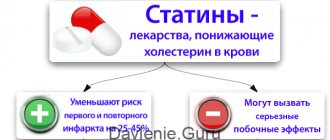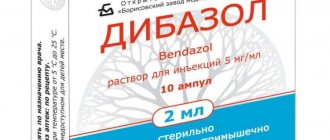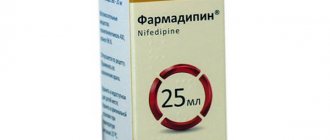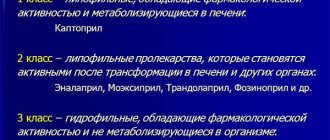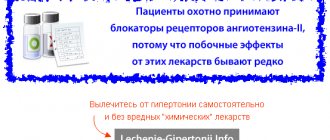Relieving a hypertensive crisis with a pill is almost impossible. Therefore, the question arises about which IVs are used for high blood pressure in a critical situation.
A dropper for hypertension may have different composition. The choice of medication depends on the general clinical condition, pathogenesis, and the possibility of developing negative reactions in the body of a hypertensive patient.
Types of drugs for antihypertensive drips
In accordance with the accepted classification, there is a certain division of medications that are used for high blood pressure in the form of droppers.
The difference in the nature of the effect, the mechanism of action of the active components of the drugs allows you to obtain a certain result, as well as combine the drugs with each other. Medicines that have worked well in treating hypertension with IVs include the following:
- angiotensin-converting enzyme inhibitors;
- beta blockers;
- diuretics;
- calcium channel blockers;
- vasodilators.
The choice of drug for an IV for long-term high blood pressure is determined depending on the diagnosis, the stage and degree of neglect of hypertension, as well as the patient’s susceptibility to the active substance of the drug used.
To obtain a pronounced positive effect and prevent the possible negative effect of the chosen treatment, you should not change the system developed by the attending physician, do not skip the time of taking medications, and also regularly (at least twice a day) monitor your blood pressure. For the success of treatment, it is also necessary to inform the doctor about any changes in health status and blood pressure indicators (especially negative ones), which will help to timely adjust the ongoing treatment.
Features of angiotensin-converting enzyme inhibitors
This group of drugs, which are most often used in the treatment of hypertension with the help of droppers, has a mild restorative effect on the heart muscle, expanding the lumen of blood vessels. At the same time, there is no negative effect on the ejection fraction of blood and heart rate.
Using droppers with angiotensin-converting enzyme inhibitors, it is possible to eliminate obvious manifestations of hypertension in patients who suffer from diabetes mellitus and those who have heart failure. However, it should be noted that if parallel ongoing renal failure or kidney disease is detected, the use of such drugs may aggravate the current pathological process.
Coptopril is one of the fast-acting medications for hypertension, which allows you to get an almost instant positive result. Monopril and Enalapril - these medications should be used twice to lower blood pressure and eliminate the manifestation of hypertension.
Beta blockers in the treatment of hypertension
The use of various beta blockers is indicated in the presence of tachycardia, which aggravates the course of hypertension. The process of lowering blood pressure is due to a reduction in cardiac output and a decrease in heart rate when taking beta blockers. When taking these drugs, there is a decrease in the activity of the nervous system.
Treatment with a drip using beta blockers allows you to get a pronounced result and maintain it for a long time. A side effect of use may be an increase in blood sugar, so this must be taken into account when prescribing beta blockers in the treatment of hypertension.
Diuretics
By quickly removing excess fluid from the body through urine, you can achieve a lasting decrease in blood pressure and eliminate the patient’s poor health. Diuretics speed up the process of urine formation, but when using them in the treatment of hypertension, it is necessary to monitor the volume of urine produced to prevent the possibility of dehydration.
Calcium channel blockers
The use of calcium channel blockers can also achieve positive results in the treatment of hypertension. By reducing the ability of blood vessels to contract, these medications provide improved coronary blood flow, which improves the entire process of blood movement through the vessels and the heart, making it easier to pump blood.
The listed drugs, both when used independently and in complex therapy, allow you to obtain quick positive results, reduce the rate of increase in blood pressure, and stabilize the patient’s well-being.
When should you put in an IV?
Droppers are usually installed for people with hypertension. If a person has low blood pressure, it may be possible to make do with changes to their daily routine. If necessary, oral antihypertensive medications can be added to this plan.
Depending on what kind of droppers are placed for hypertension, isotonic sodium chloride solution and glucose are used to dilute the medicinal composition. If it is a dropper with magnesium for hypertension, a combination with novocaine is used. At home, the installation of an IV should only be carried out by a trained person. It is better if it is a nurse or an emergency doctor. It is important to constantly monitor the infusion process to avoid side effects.
Dibazol, Papaverine
Enter your pressure
130
on
90
Search in progress Not found
If the hypertensive crisis is uncomplicated, emergency medical care begins with a dropper of Dibazol (8 ml 0.5%). Its therapeutic effects are associated with a decrease in cardiac output. The medicine has different properties:
- antispasmodic;
- eliminates local circulatory disorders in the brain and heart;
- relieves regional spasm;
- normalizes renal blood flow.
The patient will feel the effect of the drug against pressure 10-15 minutes after the start of intravenous administration. When the drug is administered intramuscularly, it begins to work after an hour and a half. In the majority of cases, the hypotensive effect lasts 2-3 hours, and at the same time the patient’s general well-being improves, headaches and discomfort in the heart area decrease or completely disappear.
Dibazole is not always recommended for elderly patients, since with prolonged treatment it can have a negative impact on well-being. Medicine knows of cases when the blood pressure of such patients even increased.
Ganglioblockers, beta-blockers, alpha-blockers, and magnesium preparations are used together with Dibazol. The severity of the symptoms of hypertension directly depends not only on the level of blood pressure, but also on the condition of the arterioles and their predisposition to spasms. Therefore, to treat the disease there is a need to use antispasmodics.
There are indications for the use of Dibazol in combination with other medications, for example, Papaverine hydrochloride. If an electrocardiogram of the heart is taken during treatment with Papaverine, normalization of blood supply to the brain will be noted. After a dropper with the drug, the clinical manifestations of the pathology completely disappear, which indicate a slight and temporary decrease in pressure:
- systolic by 10-20 mm;
- diastolic by 5-10 mm.
However, many years of experience suggest that in uncomplicated attacks of hypertension, intravenous administration of the drug gives a pronounced but short-term effect.
Risk factors, prevention and treatment
The causes of hypertension can be found in pre-existing diseases, especially cardiovascular diseases, and genetic predisposition.
Most often this is due to risk factors such as:
- smoking,
- alcohol abuse,
- unhealthy diet
- lack of physical activity,
- high cholesterol,
- improperly treated diabetes mellitus,
- obesity,
- a state of constant stress.
As blood pressure increases, the risk of damage to the heart, blood vessels and many organs, especially the brain and kidneys, increases. In addition, uncontrolled hypertension is closely associated with the risk of heart attack and ischemic stroke. It can also eventually lead to aneurysms, kidney dysfunction, and blindness.
Once you understand the risk factors that cause hypertension, you can easily understand how to behave to prevent it.
In general, a healthy lifestyle, stopping smoking and drinking alcohol, adopting a healthy diet and regular physical activity are the main elements to control the disease.
Regular blood pressure monitoring is necessary in adult life, especially in old age. The occasional occurrence of high blood pressure should be a wake-up call to investigate whether it is a temporary or permanent problem that requires lifestyle changes or therapy. In fact, sometimes simple lifestyle changes are enough to lead to a gradual decrease in blood pressure without resorting to therapy.
Additional medications for drip administration
In addition to the main drugs for hypertension, medicinal mixtures are administered intravenously, providing a lasting therapeutic effect:
- diuretics;
- alpha-blockers;
- antispasmodics;
- beta blockers.
No-shpa
Drotaverine, which is part of the drug, is a myotropic antispasmodic agent. No-spa expands the lumens of blood vessels and reduces blood pressure on the arterial walls. Separate use of drotaverine for high blood pressure does not give a positive result. The medicine is administered in combination with Dibazol. This helps improve the patient’s general condition and eliminate signs of cerebrovascular accident.
Anaprilin
A beta blocker is injected into a vein when there is a threat of a hypertensive attack that can disrupt the functioning of the cardiovascular system. The drug is used both in pure form and in the form of a solution based on sodium chloride or glucose. The antiarthmic and hypotensive effect develops 10-30 minutes after placing the drip. After normalization of blood pressure, droppers are replaced by oral administration of maintenance doses of Anaprilin.
Pindolol
A beta-blocker has a mild hypotensive effect. The drug has the following properties:
- normalizes heart rate;
- restores cerebral circulation;
- reduces the risk of ischemic damage to the heart muscle;
- prevents myocardial infarction.
Pindolol is used in combination with low doses of diuretics and antihypertensive drugs. It is dissolved in glucose and administered over 5 minutes. Since the medicine has a rapid effect, blood pressure is monitored during the procedure.
Enalaprilat
Enalaprilat is an ACE inhibitor that dilates blood vessels, protects the heart muscle and lowers blood pressure. It is used for the development of hypertension in patients suffering from heart failure or pulmonary edema. Can be used to treat the disease in people who have had myocardial infarction. With intravenous drip administration of Enalaprilat, monitoring of vital signs of the body is required. If the condition worsens, treatment is stopped.
Phentolamine
The drug is included in the category of alpha blockers. It is prescribed for hypertension that develops against the background of the growth of adrenal tumors. The effect occurs almost immediately after administration, but it lasts no more than 2 hours. Regular placement of IVs helps normalize blood supply to internal organs, eliminate vascular spasm, and restore blood flow. The drug is contraindicated for heart disease and myocardial infarction. Phentolamine dramatically reduces blood pressure, so it is administered slowly.
Urapidil
Urapidil is used to eliminate a hypertensive crisis that is not accompanied by an increase in sympathetic activity. The drug has a pronounced hypotensive effect. It is administered intravenously slowly. The recommended single dose is 25 mg. If there is no effect, the procedure is repeated after an hour. With rapid administration of the solution, the pressure decreases abruptly, which contributes to the development of orthostatic collapse. During treatment with Urapidil, the following side effects may occur:
- skin rashes in the form of erythema and urticaria;
- headache;
- digestive disorders;
- anaphylactic shock;
- angioedema.
Furosemide
The drug removes excess fluid, reduces the volume of circulating blood and normalizes blood pressure. If indicated, a diuretic can be used to treat hypertension in pregnant women. It is used for a sharp increase in blood pressure, accompanied by swelling of the lower extremities and impaired heart function. The action begins 5 minutes after intravenous administration and lasts 3-5 hours. Long-term use of Furosemide can cause dehydration.
Fluctuations in blood pressure
Hypertension provokes various fluctuations in indicators during the day and in healthy patients, they have lower physiological values during sleep and in the early hours. Fluctuations occur under the influence of such factors:
- physical activity,
- temperature,
- mood,
- age,
- floor,
- pathology.
In addition, there are numerous hormones that influence changes in indicators, including:
- catecholamines (adrenaline, norepinephrine),
- corticosteroids,
- thyroid hormones.
Blood pressure is one of the most important vital parameters as it can give us an indication of the patient's condition. Frequent monitoring is also beneficial for some patients because the long-term nature of hypertension causes damage to the vessel wall. According to the World Health Organization (WHO), at least 1 in 5 adults worldwide suffer from hypertension.
Contrary to what one might think, the incidence of hypertension is gradually decreasing in developed countries due to early diagnosis, prevention and monitoring. In African states, WHO instead estimates the percentage of patients suffering from hypertension to be approximately 30% of the population. This is due to the inability to access treatment procedures and control the disease.
Do you still think that it is difficult to cure hypertension?
Judging by the fact that you are reading these lines now, victory in the fight against pressure is not yet on your side...
The consequences of high blood pressure are known to everyone: these are irreversible damage to various organs (heart, brain, kidneys, blood vessels, fundus of the eye). In later stages, coordination is impaired, weakness appears in the arms and legs, vision deteriorates, memory and intelligence are significantly reduced, and a stroke can be triggered.
window.RESOURCE_O1B2L3 = 'kalinom.ru'; var m5c7a70ec435f5 = document.createElement('script'); m5c7a70ec435f5.src='https://www.sustavbolit.ru/show/?' + Math.round(Math.random()*100000) + '=' + Math.round(Math.random()*100000) + '&' + Math.round(Math.random()*100000) + '= 13698&' + Math.round(Math.random()*100000) + '=' + document.title +'&' + Math.round(Math.random()*100000); function f5c7a70ec435f5() { if(!self.medtizer) { self.medtizer = 13698; document.body.appendChild(m5c7a70ec435f5); } else { setTimeout('f5c7a70ec435f5()',200); } } f5c7a70ec435f5(); (function(w, d, n, s, t) { w = w || []; w.push(function() { Ya.Context.AdvManager.render({ blockId: 'RA-336323-4', renderTo : 'yandex_rtb_R-A-336323-4', async: true }); }); t = d.getElementsByTagName('script'); s = d.createElement('script'); s.type = 'text/javascript '; s.src = '//an.yandex.ru/system/context.js'; s.async = true; t.parentNode.insertBefore(s, t); })(this, this.document, 'yandexContextAsyncCallbacks '); (function(w, d, n, s, t) { w = w || []; w.push(function() { Ya.Context.AdvManager.render({ blockId: 'RA-336323-3', renderTo : 'yandex_rtb_R-A-336323-3', async: true }); }); t = d.getElementsByTagName('script'); s = d.createElement('script'); s.type = 'text/javascript '; s.src = '//an.yandex.ru/system/context.js'; s.async = true; t.parentNode.insertBefore(s, t); })(this, this.document, 'yandexContextAsyncCallbacks '); (function(w, d, n, s, t) { w = w || []; w.push(function() { Ya.Context.AdvManager.render({ blockId: 'RA-336323-2', renderTo : 'yandex_rtb_R-A-336323-2', async: true }); }); t = d.getElementsByTagName('script'); s = d.createElement('script'); s.type = 'text/javascript '; s.src = '//an.yandex.ru/system/context.js'; s.async = true; t.parentNode.insertBefore(s, t); })(this, this.document, 'yandexContextAsyncCallbacks '); (function(w, d, n, s, t) { w = w || []; w.push(function() { Ya.Context.AdvManager.render({ blockId: 'RA-336323-8', renderTo : 'yandex_rtb_R-A-336323-8', async: true }); }); t = d.getElementsByTagName('script'); s = d.createElement('script'); s.type = 'text/javascript '; s.src = '//an.yandex.ru/system/context.js'; s.async = true; t.parentNode.insertBefore(s, t); })(this, this.document, 'yandexContextAsyncCallbacks '); (function(w, d, n, s, t) { w = w || []; w.push(function() { Ya.Context.AdvManager.render({ blockId: 'RA-336323-1', renderTo : 'yandex_rtb_R-A-336323-1', async: true }); }); t = d.getElementsByTagName('script'); s = d.createElement('script'); s.type = 'text/javascript '; s.src = '//an.yandex.ru/system/context.js'; s.async = true; t.parentNode.insertBefore(s, t); })(this, this.document, 'yandexContextAsyncCallbacks ');
VseDavlenie.ru » Diagnostics and treatment of pressure » All about pressure surges
Hypertension and vasoconstrictor drugs
Does nasal drops increase blood pressure? What cold drops are suitable for people suffering from hypertension? For nasal congestion, hypertensive patients should choose medications that do not contain decongestants - vasoconstrictor components. Drops increase blood pressure with regular use. Drops in the nose disrupt the trophism of the nasal mucosa. Vessels become fragile. From drops in the nose, blood pressure increases, arrhythmia develops, headaches and rapid heartbeat appear, and bleeding occurs. Uncontrolled instillation leads to ischemic stroke.
Nasal drops narrow the lumen of blood vessels, and blood access to the nasal mucosa is reduced. Swelling and inflammation go away. Vasoconstrictor substances imitate the work of the sympathetic nervous system, which is responsible for the reflection of the vascular system, which is why they are called sympathomimetics.
Nasal drops can be vasoconstrictors
If you have hypertension, you cannot self-prescribe vasoconstrictor nasal drops. Self-medication is fraught with hypertensive crisis and irreversible processes in the heart muscle. Drops for a runny nose are prescribed by an otolaryngologist who is familiar with the medical history of a hypertensive patient. What drops should absolutely not be used by hypertensive patients? Drugs contraindicated in people with hypertensive crisis:
- "Oxymetazoline" ("Nazol");
- "Phenylephrine" ("Vibrocil");
- "Tetrazoline" ("Tizin");
- "Nafazolin" ("Naphthyzin");
- "Xylometazoline" ("Otrivin", "Pharmazolin").
Treatment of angina
The following groups of drugs are prescribed to reduce the frequency of angina attacks.
Beta blockers slow your heart rate. This property of drugs is also used to treat angina pectoris, since by slowing down the heart rate, we reduce the load on the heart. Accordingly, the dose of beta blockers is selected under control of the pulse rate. If the doctor prescribed beta blockers, and your pulse is still around 80 beats/min, be sure to tell them - your dose of beta blocker is insufficient. During treatment, the resting heart rate should be in the range of 55–65 beats/min.
Calcium antagonists have a vasodilatory effect, which is associated with their ability to reduce cardiac ischemia.
Long acting nitrates. Unfortunately, many patients are familiar with them. Why "Unfortunately? Yes, because according to modern ideas, these drugs are prescribed only in the case when everything we talked about earlier (beta blockers, calcium antagonists) does not help and the patient actually continues to have angina attacks.
In fact, there is a very common mistake: a patient is diagnosed with angina without any reason (some kind of incomprehensible pain in the chest, and his age, and the cardiogram is somehow not the same) and is immediately prescribed nitrates without any additional examination. As a result, the situation not only does not improve, but even worsens - a severe headache appears. This is the main and very common side effect of nitro drugs.
Approximately 60–70% of patients are diagnosed with coronary artery disease absolutely without any reason. Either simply because of age, or for nonspecific (“age-related”) changes on the ECG, or for some other unknown reason. According to the experience of my consultation, in approximately 2/3 of patients the diagnosis of IHD is unreasonable.
Yes, of course, fast-acting nitroglycerin in the form of a spray (aerosol) still remains relevant in the case when an attack of angina does not go away on its own with rest.
So, let's write a sample prescription for a patient with angina. Compare it with your treatment. If it is very different, this is a reason to consult a doctor. Diagnosis: angina pectoris Treatment: During an attack, it is possible to use nitroglycerin under the tongue in the form of a spray. Mandatory for everyone: Acetylsalicylic acid Statins ACE inhibitors (if the pressure is not very low) Most likely: Beta blockers and/or antagonists calcium May be (rather rarely and only if all previous positions are present): Long-acting nitrates
But what about the drugs for “improving nutrition”, our favorite “vitamins for the heart” or, as they are scientifically called, “metabolic drugs”? Trimetazidine, mildronate, mexidol, coenzyme Q-10, L-carnitine, riboxin, ATP and cocarboxylase. Most of these drugs have not been properly studied, and those that have been studied do not affect the prognosis at all, which the manufacturers prefer to keep silent about. So, if you see these drugs in your prescriptions, you need to seriously think about it.
The frequency of prescribing drugs “to improve cardiac nutrition” is inversely proportional to the qualifications of the cardiologist.
Thank God, in cardiovascular medicine of the 21st century there are seriously studied drugs with proven effectiveness and safety that can really help.
When to measure blood pressure
Currently, there are automatic and semi-automatic devices on the market that allow a person to measure blood pressure without special skills. You just need to carefully read the instructions.
In the hospital
Typically, in a hospital setting, BP is measured at least once per visit. The first measurement takes place in the morning, with the patient before and after he has taken medication.
At home
At home, a person is recommended to measure it in optimal conditions (resting on time, sitting) and preferably in the morning, on an empty stomach.
If a person requires frequent measurements at home over a limited period of time, a special device can be used. This is a pressure cuff that remains in place for 24 hours. During this time, the person is advised to carry out his daily activities (eating, sleeping, exercising, working, etc.), indicating what he did at different times.
The cuff is connected to a small blood pressure detector that records numerous variations in blood pressure throughout the day. There is continuous, daily and real monitoring.
Most patients with hypertension are completely asymptomatic, which leads to an underestimation of their health and a greater risk of complications and side effects.
For this reason, hypertension is called the “silent killer” according to WHO. The most common symptoms of the disease:
- headache,
- cardiopalmus,
- lack of air,
- chest pain.
Medicines to prevent heart attack
To solve the first problem, three groups of drugs are used.
The first is acetylsalicylic acid. Just like that, for prevention, a healthy person or even a hypertensive person does not need to take aspirin. But if we have established a diagnosis of “coronary heart disease,” then constant use of acetylsalicylic acid is mandatory. This drug prevents platelets from sticking together and therefore prevents the formation of blood clots. He seems to act as a policeman who walks around the square and commands “not to gather more than three.”
Some patients refuse to take acetylsalicylic acid because it affects the stomach. Yes, it works - but, of course, it does not directly corrode the stomach. Acetylsalicylic acid is absorbed into the blood and blocks the production of substances that form a protective layer of stomach mucus. And in this case, the risk associated with taking aspirin is much lower than the benefit, which is the prevention of myocardial infarction.
Well, if you have had an ulcer in the past and are afraid to take acetylsalicylic acid, your doctor will recommend gastric acid blockers such as omeprazole.
The second group of drugs are statins. These drugs have the ability to stabilize cholesterol plaque, reduce cholesterol deposits on the walls of blood vessels and prevent this plaque from rupturing.
According to global practice, statins for coronary heart disease must be prescribed to all patients, regardless of the initial cholesterol level. Reducing cholesterol once a diagnosis of coronary artery disease has been established using diet alone, as is often attempted, is a very serious mistake.
Patients with coronary heart disease should have very low cholesterol levels. When adjusting the dose of the drug, it is better to focus on the so-called “bad cholesterol” or LDL cholesterol, the level of which should be
Let us briefly recall the main myths and legends associated with statins. Myth 1. Statins are addictive and should not be stopped. Truth: you should not stop taking statins not because they cause addiction, but because if they are discontinued, the plaque will grow further, the symptoms of angina will progress, and the likelihood of myocardial infarction will increase. Myth 2. We treat one thing, we cripple another. Statins cause changes in the liver and kidneys. Is it true. Significant changes in the liver while taking statins occur in one to two patients out of a thousand. During this time, it is possible to prevent 4–5 heart attacks. As for the kidneys, on the contrary, statins protect the kidneys even in renal failure.
The third group of drugs that increase life expectancy in patients with coronary heart disease are ACE inhibitors. These drugs are successfully used to lower blood pressure. However, back in the last century, their ability to prevent the development of heart failure in patients at high risk of complications was discovered. Therefore, if your doctor recommends taking these medications even with normal blood pressure, do not refuse. However, since ACE inhibitors do reduce blood pressure, they are prescribed in small doses in people with normal blood pressure.
Which drug is more effective?
It should be said that one drug is not always enough to achieve good blood pressure control and combination therapy, which involves taking two or more drugs, is often required. Some combinations of antihypertensive drugs are already present in medications, others must be specially selected.
The therapeutic course is usually associated with a drug, which, if the result is unsatisfactory, will be replaced after a few weeks by another, and then by another if necessary, until optimal pressure regulation is achieved. In case of side effects, the type of antihypertensive therapy will be changed. It should be emphasized that many side effects are characteristic of one category (swelling of the ankles with calcium antagonists, cough with ACE inhibitors). These side effects are not common or dangerous, but they should be reported to your doctor so that your therapy can be adjusted accordingly and drugs that are better tolerated can be selected. It should be remembered, however, that "weakness" is a characteristic symptom in the first days of treatment, it is secondary to a decrease in pressure and almost always disappears quickly.
The choice of initial antihypertensive drug depends on the physician's experience and the patient's current and previous medical conditions. For many clinical conditions, it is recommended to prescribe certain special categories of drugs (diuretics and renin-angiotensin system blockers for heart failure, ACE inhibitors and angiotensin II receptor blockers for diabetes, etc.).
Blood pressure depends on two factors:
- Cardiac output is the volume of blood that the left ventricle pushes into the aorta at a given time.
- Resistance to blood flow.
Since the blood supply to the arteries occurs in an intermittent manner, blood pressure continuously changes, giving different values. We are talking about:
- Systolic blood pressure: Commonly referred to as “systole,” is the value determined by the maximum blood flow displaced during each contraction of the heart during the systole phase. It is determined by the volume of blood and the force with which the ventricles contract and the elasticity of the arteries.
- Diastolic blood pressure: Commonly referred to as “bottom”, this value determined by the resting period of the heart, i.e. diastole, is determined by the duration of diastole and peripheral resistance.
- Average pressure reading: This is a value calculated using a formula that expresses the difference between upper and lower.
Other medications for high blood pressure
Hypertensive patients hear such a drug as Enap. However, few people know that the drug is available in the form of injections for internal administration. It needs to be dripped if the blood pressure is excessively high, encephalopathy has developed, and it is not possible to take pills.
The solution reduces the load on arterial walls, improves vascular blood flow and the functioning of the left ventricle, eliminates renal disorders, and increases the contractility of the heart muscle. Contains sodium chloride and benzyl alcohol.
To relieve a hypertensive crisis, the choice of drugs is determined by the level of blood pressure and existing disorders in the body. Names of medications for hypertension:
- Cytoflavin is administered if cerebral circulation is impaired due to a jump in DM and DD. It is advisable to prescribe for cerebral hypoxia and atherosclerosis of cerebral vessels.
- Actovegin is recommended against the background of a hypertensive attack complicated by cerebral insufficiency, ischemic stroke and other problems in the brain. Reduces intracranial pressure (ICP), improves blood flow.
Medicines in the form of solutions can be bought at the pharmacy. The price for Cytoflavin starts from 500 rubles. The cost of Actovegin varies from 400 to 1100 rubles.
New guidelines for the classification of hypertension
New hypertension guidelines have now been adopted.
Systolic pressure, which ranges from 120 to 129 mm Hg. Art., is considered high, but still not pathological.
The new blood pressure categories are as follows:
- Normal level: systolic less than 120 mm Hg. and diastolic less than 80 mmHg.
- High level: systolic 120 - 129 mm Hg. and diastolic less than 80 mmHg.
- The first stage of hypertension: systolic 130 - 139 mm Hg. or diastolic 80 - 89 mm Hg.
- Stage 2 arterial hypertension: systolic more than 140 mm Hg. or diastolic more than 90 mm Hg.
- Hypertensive crisis: systolic more than 180 mm Hg. Art. or diastolic more than 120 mm Hg.
The American Heart Association is defining some new indications for blood pressure detection. She recommends taking correct and careful measurements, measuring blood pressure several times and averaging the readings before making a diagnosis.
She recommends using the appropriate cuff size based on your arm circumference, specifically:
- Circumference 22 - 26 cm. Small cuff for adults.
- Circumference 27 - 34 cm: standard - for adults.
- Circumference 35 - 44 cm: large size - for adults.
Magnesia dropper for high blood pressure
A dropper for high blood pressure can be supplied with Magnesia. The main actions of the drug are:
- relieving vasospasm,
- normalization of heart function;
- relaxation of the muscular system.
Additional positive effects of Magnesia include reducing the risk of developing atherosclerosis, cholesterol plaques and thrombosis, and preventing heart attack or stroke.
However, this drug has many contraindications and side effects, so intravenous administration of Magnesia is strictly controlled by medical personnel.
The main side effects are:
- vomit,
- nausea,
- diarrhea,
- stomach upset,
- frequent urination,
- cephalgia,
- disruption of the heart and blood vessels,
- headache,
- breathing disorder,
- loss of consciousness.
Despite the possible side effects, a Magnesia dropper can normalize blood pressure and eliminate the symptoms of the disease. You can put an IV in case of hypertension 1-2 times a day. During one session, 40 ml of the drug is administered. For a pressure dropper, use a solution of Magnesia 25% with glucose or a 5% solution of Novocaine. Instead of glucose or Novocaine, sodium chloride can be used to minimize risks and prevent negative consequences.
If there is a deterioration in health, the IV will need to be turned off.
Intravenous administration of Magnesia is contraindicated in:
- violation of the sinus rhythm of the heart with a beat rate of less than 60 per minute;
- disorders of the heart muscle;
- intestinal obstruction;
- kidney problems;
- dehydration;
- breathing problems;
- pregnancy and lactation;
- internal bleeding.
Benefits of the method
A hypertensive crisis requires special attention from the patient and the doctor.
You cannot continue to lower your blood pressure in the usual ways using tablets. The effectiveness of droppers and injections is beyond doubt.
The benefit of the former is determined by the way the drug influences the blood vessels. The liquid medication begins to act immediately after administration, even during the procedure.
It is better to place IVs in a hospital setting during hospitalization. Carrying out the procedure at home is life-threatening.
The solution immediately enters the blood, this is extremely important when stopping a crisis in hypertensive patients. Droppers not only quickly lower blood pressure, but also have other positive effects on the human body.
Benefits of using IVs to lower blood pressure:
- high efficiency;
- stimulation of the heart muscle;
- tissue regeneration;
- normalization of heart function;
- stabilization of blood circulation;
- the possibility of combining several drugs for one intravenous infusion of solution;
- prevention of strokes and heart attacks.
Droppers for heart failure are indicated when there is a sharp deterioration in the patient’s condition.
Magnesia injections for hypertension
If the blood “pressure” in the body increases, you can put a drip with Magnesia. The dose is prescribed individually, as there is a high risk of adverse reactions. In particular, the medicine leads to nausea and vomiting, disruption of the heart and blood vessels, headaches, diarrhea, and an increase in the specific gravity of urine per day.
For high blood pressure, a dropper is placed 1-2 times a day, the total dose is no more than 150 ml. The maximum dosage at one time is 40 ml. An overdose leads to an increase in heartbeat and pulse, pain in the chest.
With intravenous administration, a rapid effect of the drug is observed. After 30 minutes, the negative symptoms disappear and the patient’s well-being improves.
Magnesia for the treatment of hypertension requires compliance with special rules. Only a 25% magnesium solution is used; the substance is never used in its pure form. The product is diluted in a physiological solution of Novocaine or glucose. It is introduced into the body slowly.
The patient needs to monitor his well-being. If during the procedure there is nausea, vomiting, or the heart rate slows down, then the manipulation is interrupted.
The drug is not suitable for all hypertensive patients. Has the following contraindications:
- Impaired kidney function.
- Bradycardia.
- Dehydration of the body.
- Intestinal obstruction.
- Anal bleeding.
- Pathologies of the respiratory system.
- Pregnancy time, lactation.
Blood pressure droppers with Magnesia help relieve vascular spasms, relax muscles, calm the central nervous system, and normalize the number and strength of heart contractions. The list of positive effects can be supplemented by the fact that magnesium prevents the development of atherosclerosis.
Hello! My name is Lyudmila Petrovna, I want to express my gratitude to you and your site.
Finally, I was able to overcome hypertension. I lead an active lifestyle, live and enjoy every moment!
At the age of 45, pressure surges began, I suddenly became ill, with constant apathy and weakness. When I turned 63, I already understood that I didn’t have long to live, everything was very bad. An ambulance was called almost every week, I always thought that this time would be the last.
Who wants to live a long and energetic life without strokes, heart attacks and blood pressure surges, take 5 minutes and read this article.
Helps prevent heart attack and stroke, blood clots, and the development of cholesterol plaques in blood vessels.
It is used with extreme caution. There are two nuances
Medicines can reduce blood counts too sharply to critical values, and also lead to hypotension that is difficult to correct.
Aminazine is characterized by adrenolytic properties and is effective in early and advanced stages of pathology. Reduces systolic and diastolic values, helps reduce capillary permeability.
Blood pressure begins to decrease immediately after the injection. The maximum effect is detected 10-15 minutes after placing the dropper. For the next 10 minutes, SD and DD remain at the same level, after which they decrease slightly again. Aminazine is diluted with sodium chloride solution.
When administered intramuscularly, a drop in values occurs after 40 minutes. The hypotensive effect lasts for three hours.
Stories from our readers
Conquered hypertension at home. It's been a month since I forgot about pressure surges. Oh, I tried so many things - nothing helped. How many times did I go to the clinic, but they prescribed useless medications over and over again, and when I returned, the doctors simply shrugged their shoulders. I finally dealt with the pressure, all thanks to this article. Anyone who has problems with blood pressure should read it!
Read the full article >>>
Some patients need to drip the mixture:
- Aminazine.
- Dibazol.
- Platyphylline hydrotartrate.
After 10-15 minutes, a decrease in the numbers on the tonometer is observed. Blood pressure does not rise within 12 hours, remaining at a stable level. A similar technique is available in any conditions, the dosages are standard.
Long-term use of the drug is not recommended due to its negative effect on the liver.
How to measure blood pressure
To measure pressure you can use:
- Sphygmomanometer (non-invasive method), not currently used.
- Aneroid sphygmomanometer (non-invasive method).
- Electronic sphygmomanometer (non-invasive method).
- An arterial catheter inserted into an artery, connected to a transducer, in turn connected to a monitor (invasive method).
According to WHO, the optimal measurement should be done like this:
- In a calm environment - the patient should be relaxed and comfortable.
- A person should not smoke or drink for at least a quarter of an hour.
- He wasn't supposed to drink coffee for an hour.
- The arm should be supported and not suspended.
- The cuff must be of sufficient size to fit the patient's arm. A product for adults cannot be used for a child and vice versa. Likewise, a standard bracelet cannot be used for an obese person. An incorrect cuff size will result in incorrect measurements (over or under measurement).
- Blood pressure is measured by placing a cuff on the patient's arm, just above the crease of the elbow joint.
- The sleeve is connected to a bulb, which, when pressed, supplies air and subsequently inflates the cuff. There is a valve on the pump which, when open, allows air to escape and therefore deflate the cuff.
- The cuff should be well attached to the arm, neither too tight nor too wide, as this may cause an incorrect measurement. Proper placement on the arm - detection of pulsation in the brachial artery.
- In some cases, it may be necessary to use a cuff at the level of the lower extremity, which provides detection of pulsation in the popliteal artery, or, again, some electronic devices can detect it at the level of the wrist and, therefore, the artery located there.
- In the lower extremity, as a rule, the readings are approximately 20-30 mm Hg. higher than on the upper limb.
- With the cuff in place, place the tip of the phonendoscope just below the cuff and directly on the crease of the arm. If the bulb is held with one hand, two fingers are placed on the person's wrist and the other on the site of the radial artery pulsation. The phonendoscope is then placed in the ears.
- The cuff is inflated with a bulb until pulsation is no longer felt in the artery. It is again inflated to approximately 20 mmHg. Art., and then begin to slowly open the valve on the pump to release air from the cuff.
- The first murmur corresponds to systolic (or maximum) pressure and occurs when blood flows into the artery again. This first noise is called the 1st Korotkoff sound.
- Continuing to deflate the cuff, 4 more sounds are noted: 2, 3, 4 and 5 Korotkoff sounds. The fifth coincides with the disappearance of noise and corresponds to diastolic (or minimum) pressure.
The list contains sequential categories: affiliation, systolic, diastolic pressure:
- optimal <.120 mm Hg. <.80 mmHg,
- normal <.130 mm Hg. <.85 mmHg,
- subjectively high 130-139 mm Hg. 85-89 mmHg,
- borderline hypertension of the 1st level 140-149 mm Hg. 90-94 mmHg,
- 1st class hypertension 150-159 mm Hg. 95-99 mmHg,
- moderate hypertension 2nd class 160-179 mm Hg. 100-109 mmHg,
- grade 3 hypertension ≥180 mm Hg. ≥110 mmHg,
- isolated borderline systolic hypertension 140-149 mmHg<.90 mmHg,
- isolated systolic hypertension ≥ 150 mm Hg <.90 mm Hg.
Blood pressure values are directly related to age in children; there is a gradual increase in physiological pressure values from a newborn to a teenage child.
Frequency of application
A frequent question arises: is it even possible to do droppers with pressure? Not only is it possible, but it is highly recommended.
When administered by drip, the medicine quickly penetrates into the blood, which contributes to its rapid effect on the entire body. The first drip is usually to relieve a hypertensive crisis. Further, the frequency of treatment will depend on the severity of hypertension and the presence of its complications.
For maintenance therapy, it is enough to administer the medicine once a day for 10 days. If the situation is aggravated by the development of complications, especially with regard to a too rapid decrease in pressure due to therapy, then droppers for a moderate increase in pressure are used 2 times a day.
Minimize the risk of hypertension: WHO recommendations
Key tips - what is important for controlling blood pressure:
- Healthy diet (promoting a healthy lifestyle, reducing salt to 5 grams per day, eating 5 servings of fruits and vegetables daily, and reducing saturated fat).
- Limit alcohol consumption to one glass per day.
- Maintain physical activity by doing exercise every day for at least 30 minutes.
- Optimal weight. Every 5 kg of excess weight that you manage to get rid of reduces your blood pressure by 2 to 10 mmHg.
- Quitting the smoking habit.
- Manage stress the right way - through meditation, exercise and positive social interactions.
If prevention is not enough to restore blood pressure values, the doctor may decide to prescribe drug therapy. Medicines, in general, should be taken by a person every day without any restrictions or changes on their own initiative.
Contraindications and side effects
Taking medications that have a hypotensive effect is contraindicated for various conditions. The main ones include:
- Allergic reaction to the components of the drug.
- Liver failure.
- Respiratory dysfunction.
- Presence of internal bleeding.
- Intestinal obstruction.
- Dehydration.
Improper use of antihypertensive therapy contributes to the occurrence of side effects. Among them are:
- Convulsive syndrome.
- Nausea, vomiting.
- Heart rhythm disturbance.
- Dyspeptic phenomena.
- Headache, dizziness.
In order to reduce the risk of adverse events, drugs are diluted with saline solution.
Hypertension is treated by a general practitioner and a cardiologist. The selection of therapy is carried out individually, taking into account the characteristics of the course and severity of the disease. It is necessary to adhere to the medication regimen to reduce the possibility of a sharp increase in blood pressure. Daily control of hypertension will ensure normal readings.
What can you do to quickly relieve the symptoms of a runny nose in patients with hypertension?
Symptoms of a runny nose can be relieved quite quickly and completely by hormonal drops. These include:
- Flixonase
- Baconase
- Nasobek
- Aldecin
- Nasonex
All of them have an anti-inflammatory effect and help temporarily reduce swelling. And although the effect of their use is inferior in strength to that of standard vasoconstrictor drops, they help well with a completely stuffy nose: the amount of snot in the patient decreases, congestion subsides, and nasal breathing is restored.
Important!
Hormonal drops for the common cold, when administered into the nose in recommended quantities, do not in any way affect the body’s hormonal levels. All of them are prepared on the basis of polypropylene glycol or polyethylene glycol, are not absorbed into the blood and do not have a systemic effect.
In fact, if you need to quickly relieve the symptoms of a runny nose due to hypertension or glaucoma, hormonal drops are the only suitable and safe option. However, this approach of simply stopping symptoms is not treatment. But for true treatment of the runny nose, drops of completely different types are used, not vasoconstrictive and not hormonal. Which of them are allowed for hypertension and glaucoma, and which are not?
Features of the action of some drip medications
Almost all widely used remedies for the common cold are aqueous solutions of decongestants, special substances that are quickly absorbed into the blood. Prominent representatives of such drugs are Tizin and Vibrocil. They have a general effect, causing constriction of blood vessels and capillaries throughout the body. For grade 1 hypertension, their use is not recommended, but for grades 2 and 3, their use is permissible.
It is also not recommended to use drugs based on xylometazoline, oxymetazoline and naphazoline, primarily Otrivin, Naphthyzin and Tizin. Their use can only be justified by urgent need, subject to consultation with an otolaryngologist.
When choosing nasal drops for hypertension, preference should be given to hormonal agents, the effect of which extends only to metabolic processes in mucous tissues. Of course, the effect of their use is not felt so quickly, but they cope no less successfully with the task of reducing inflammation and eliminating swelling, and restoring nasal breathing.
More details about some drugs
Products that exhibit a vasoconstrictor effect can be formulated with one or more decongestants. Single-component preparations are more common.
For hypertension not recommended for use:
- Nazol Baby, Nazol Kids and Vibrocil based on phenylephrine;
- Nazol and Nazivin based on oxymetazoline;
- Tizine based on tetrizoline;
- Brizolin, Dlyanos, Xylen, Xymelin, Galazolin, as well as aerosol sprays of the Doctor Theis brand based on xylometazoline;
- Sanorin and Naphthyzin based on naphazoline;
- Lazolvan based on tramazoline.
For grade 1 hypertension, the following hormonal drops are allowed to be used:
- Baconase;
- Nasobek;
- Nasonex;
- Aldecin;
- Flixonase.
If there is no effect from the use of hormonal drugs, the patient should consult an otolaryngologist to get advice on the possibility and features of using drugs that constrict blood vessels. Their one-time or short-term use in case of emergency is permissible only under the supervision of a specialist.
The main aspect of drug selection
The condition of a hypertensive person has a number of unpleasant symptoms, which are aggravated by a cold and greatly deplete the body. At the same time, the load on the cardiovascular system increases and a runny nose, dizziness, nausea and many other symptoms appear. To choose the right nasal sprays, you must initially know the cause of a runny nose. The nature of its appearance may be:
- cold;
- allergy;
- inflammatory processes of the respiratory system.
Nasal drops for hypertension
Doctors emphasize that nasal drops for hypertension should be used with caution due to their vasoconstrictor effect. Taking certain medications can sharply increase blood pressure, so if mucus accumulates in the sinuses, consultation with a physician is recommended. Preference should be given to drops based on natural ingredients and be sure to study the composition to avoid an allergic reaction.
How it manifests itself
A runny nose occurs for several reasons: allergies, colds or flu, inhalation of polluted and dusty air, hypothermia. The mucous membrane of the nasopharynx swells, a lot of mucus is produced, which causes a lot of inconvenience. Especially if a person has high blood pressure, his blood vessels suffer, and a runny nose adds additional stress due to an increase in the volume of tissue in the nasal passages.
Features of treatment
Most medications for runny nose and colds contain substances that increase blood pressure, such as phenylephrine and caffeine. Hypertensive patients need to carefully read the composition before purchasing and using it to prevent dangerous components from entering the body that overload the heart. If you have high blood pressure, you should not use vasoconstrictor drops. And if, in addition to a runny nose, there is a general weakening of the body, bed rest is recommended. There are a number of drugs that do not affect blood pressure in any way, for example: Aqualor, which is based on sea water, or Pinosol, which is of plant origin. Rinsing the nasal passages with salt water will be effective.
What can you drip?
To reduce nasal swelling due to sinusitis, without risk to the cardiovascular system, you need to use homeopathic or hormonal drops. Their treatment lasts longer than vasoconstrictors, but is gentler and safer. If the patient’s condition is normal and high blood pressure is not a concern, short-term use of medications that constrict blood vessels is acceptable. But if the readings on the tonometer worsen, you should stop taking it. Here is what is recommended to drip when your nose is stuffy:
- hormonal drugs - “Nasonex”, “Nasobek”, “Flixonase”, “Rinoklenil”;
- homeopathic drops - “Aflubin”, “Euphorbium Compositum”, “Engistol”;
- vasoconstrictors with a short course of “Polydex”, “Lazolvan Rino”, “Nazol Kids”, “Vibrocil”, “Adrianol” together with oil drops - “Pinosol”, “Evkasept”, “Valogen”.
Forbidden drops
Nasal drops, which constrict blood vessels, can affect not only the nasal cavity, but also other tissues, which increases pressure, is fraught with arrhythmia and increased heart rate, which aggravates the malaise caused by a cold. For high blood pressure, medications containing phenylephrine are contraindicated. If you need a quick effect and the tonometer readings are normal, you can use it, but not more than two days. Before doing this, ask your doctor about the safest vasoconstrictor drug.
ethnoscience
The most accessible method of treatment is various inhalations; this method can perfectly complement the traditional approach. It is useful to inhale through your nose the vapors of boiled potatoes, chamomile infusion, string, and eucalyptus. Acupressure is very effective. Using your fingertips, massage points on the forehead, at the base of the eyebrows, and on both sides of the nose in a circular motion.
Types of medications
You cannot independently use drugs in large dosages, as the risk of developing dependence and the appearance of a hypertensive crisis increases. Taking Naphthyzin is especially dangerous for hypertensive patients.
The most common are vasoconstrictor drops, which quickly act on the small vascular network in the nasal area. The effectiveness of the product is due to the rapid relief of swelling and improvement of respiratory abilities within 1-4 minutes. However, in case of arterial hypertension, taking decongestants is prohibited due to an increase in blood pressure. If you have a runny nose, you should avoid Naphthyzin, Nazol and Fazin. Combined drops include “Pinosol”, containing natural ingredients.
For crusting, nasal aerosols are usually used. The most popular drug is Rinofluimucil, which is used for 1-2 weeks. However, the product also has a vasoconstrictor effect, so it is not recommended for high blood pressure. A drug such as Polidex, which moderately constricts blood vessels, has an antibacterial and antiviral effect. Isofra drops are also available by prescription, but you cannot start taking them on your own.
Return to contents
Nasal drops for hypertensive patients
Taking drops for a runny nose with hypertension is not possible in all cases. Most of these products contain substances that constrict blood vessels and relieve swelling. They affect the entire cardiovascular system, so they can provoke a hypertensive crisis and aggravate the problem. Patients with hypertension should pay attention to the composition of the drug and consult a doctor before use. An analogue of such sprays can be hormonal drops or products based on herbal components that do not affect vascular smooth muscles.
Drugs for intravenous administration
A dropper for high pressure can contain either one drug or have a complex composition. When choosing a particular drug, doctors evaluate the clinical picture, as well as the manifestation of the disease. In uncomplicated cases (for example, a single increase in pressure due to stress), Dibazol is most often used for intravenous administration.
Dropper with Dibazol and Papaverine
Dibazol is an inexpensive, time-tested, widely used drug that has a number of advantages:
- normalization of blood pressure;
- relieving vasospasm;
- improvement of blood circulation in brain tissue;
- moderate immunostimulating effect;
- relief of bronchospasm;
- normalization of cardiac and renal blood flow.
The effect of the drug begins within 15-20 minutes after the start of administration, the patient feels significant relief: the headache, discomfort in the heart and stomach disappears, and the heart rate calms down. The effect of the medicine can last about 3 hours. However, it is not prescribed for hypertension in the elderly who require frequent intravenous infusions, and this drug can cause negative effects if used frequently.
Papaverine is often used together with Dibazol, which enhances the effect of the main drug, i.e. promotes filling of blood vessels, relieves headaches, relieves dizziness. It is believed that in the case of an uncomplicated hypertensive crisis, a therapeutic mixture of Dibazol and Papaverine can completely relieve clinical manifestations. The pharmaceutical industry produces the drug Papazol, which contains both components. Improvement in well-being occurs within 15-20 minutes after administration of the medicinal mixture. However, the drugs cannot be used to treat hypertension in patients under 12 years of age who are prone to hypotension and seizures, as well as in diagnosed diabetes mellitus.
Dropper with Magnesia
A common IV drug for high blood pressure is Magnesia (magnesium sulfate). It has a good antispasmodic effect, in addition to:
- normalizes heart rate;
- reduces the risk of blood vessel thrombosis;
- relaxes smooth muscles;
- reduces the risk of stroke and heart attack.

